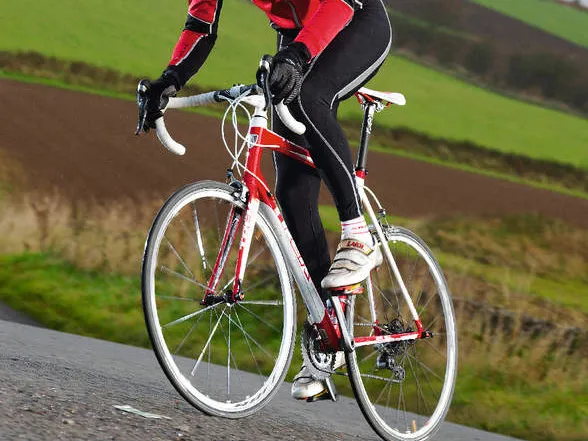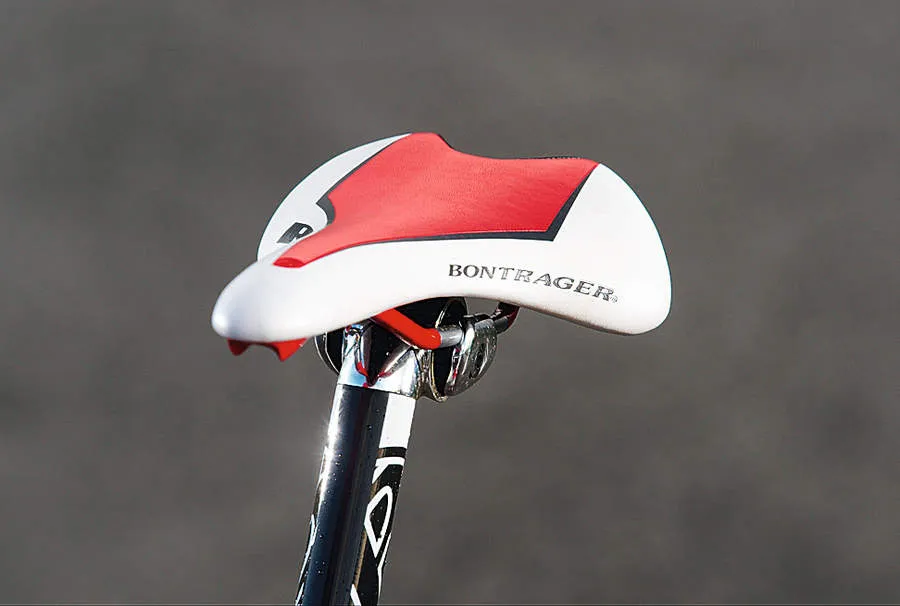Trek's carbon Madones get a lot of attention – not surprising given the number of high-profile race victories they’ve chalked up under the likes of Lance Armstrong and Alberto Contador. Tucked away just below them in the line-up are the aluminium 2- Series models, which share the same geometry and many similar ride characteristics at more affordable prices.
Ride & handling: Plenty of long-ride comfort, but it's difficult to get aero for racing
Hitting the scales at just under 19lb for the 60cm model, the Trek is a middleweight, but there’s very little frame flex to dull its reactions. Fire up your muscles and it’ll respond dutifully with a surge of speed, if lacking the spark of price rivals from the likes of Boardman.
It’s comfortable enough too, the fairly high front end taking some of the strain off your lower back, and the overall ride-quality is pretty smooth. The saddle is one only a mother could love – there’s not enough padding or hull flex for our taste – but that aside, the Trek handled our worst-surfaced test route just fine.
Head for the hills and, though the 2.5 isn’t the most natural climber in the world, it gets to work without complaint – the compact chainset giving you the ratios you need to keep spinning up the steep stuff.
The flipside is that you can run out of gears on the fastest descents, which is a shame because this bike has a stable, confidence-inspiring assurance that makes you want to push harder.
The newly improved Shimano Ultegra brakes add to that feeling. Thanks to a better block compound they come with more stopping power this year, especially in wet conditions, and that gives you the confidence to fly downhill.
The tall head tube that’s such a bonus for training in comfort makes getting into a flat-backed race position more dificult. With that in mind, take a good look at the Trek if you’re after a solid-performing bike for non-racing duties – but it wouldn’t be top of our list if we wanted something that could handle racing too.
Chassis: Fairly restrained aluminium frame plus carbon-bladed fork
Trek hydroform the 2.5’s frame from their medium grade of Alpha aluminium but, unlike some manufacturers who go down the ‘look what we can do’ route when faced with the shaping possibilities, the finished article is fairly restrained.
The shield-profiled top tube, which starts out big and chunky at the head tube junction, slims down along its length, while the down tube morphs from a teardrop shape to a broad oval that extends across virtually the full width of the bottom bracket shell.
Out back, the seatstays and chainstays are both straight, while the fork, like most at this price, is carbon bladed with an alloy steerer. What’s different is that it’s SpeedTrap compatible – which means you get a slot in one leg for neatly fitting a wireless computer sensor.
In terms of geometry, the 2.5’s head tube is longer than average – 21cm on our big blokes’ 60cm model – and you don’t get a low front-end option like you do on the top-end Madones. This fact had us immediately swapping headset spacers around to get a lower, more aggressive setup, but you might like the slightly more upright position.
The top tube slopes downwards, though not severely, to give you extra standover room, the smooth welds are barely noticeable beneath the lustrous paintwork and you get mudguard eyelets front and rear.
Equipment: Polished performance from Ultegra groupset, but we'd swap basic saddle and tyres
The Trek comes fitted with a full complement of Shimano’s second-tier Ultegra components – apart from the 105 cassette that they’ve snuck in at the back – and it’s slick, high-performing kit.
For 2010, Shimano have made some major upgrades, including to the levers, which now have more comfortable hoods and composite levers that are angled further outwards for better fingertip control.
The gear cables also join the brake cables underneath the bar tape for the first time, although that’s a mixed blessing. It might neaten things up, but it makes fitting clip-on tri bars just a touch more awkward.
Absolutely everything else comes from Trek’s own Bontrager brand, including the Race wheels, which are reasonably light and surprisingly flex-free when you get out of the saddle. They’ll be even more lively if you upgrade the low-rent tyres.





